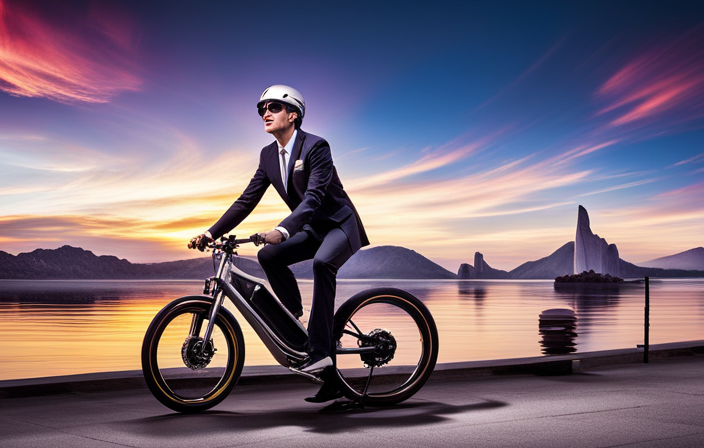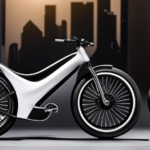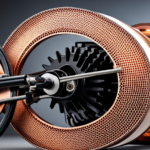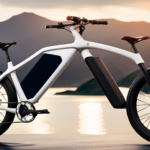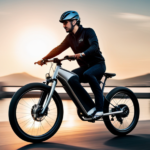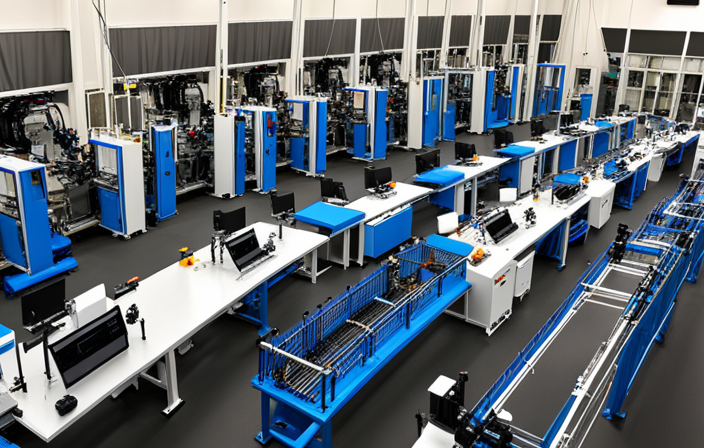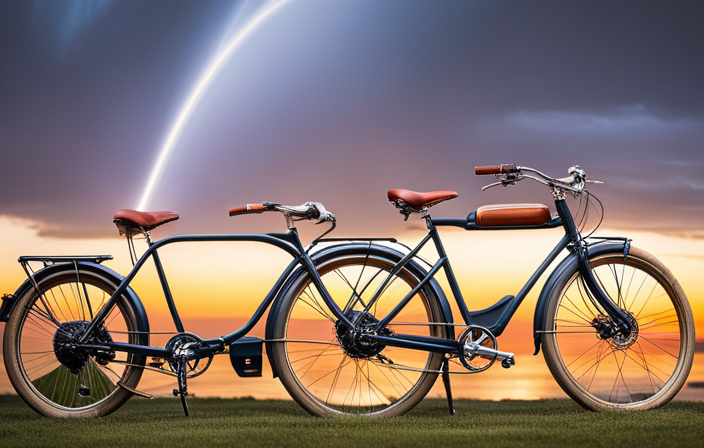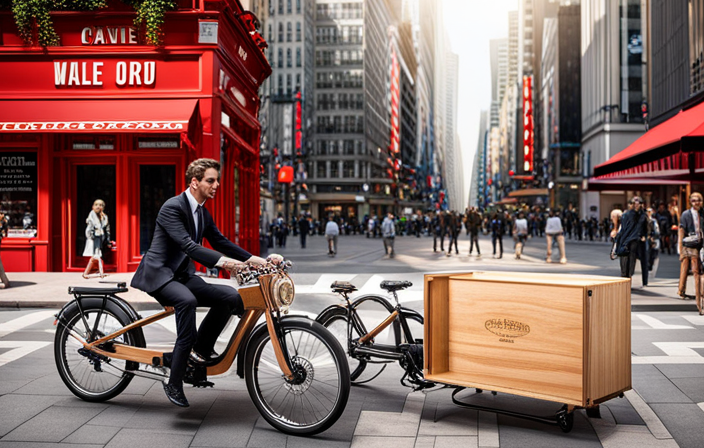Are you prepared to boost your performance and elevate your cycling experience?
When it comes to electric bikes, finding the best wattage is like unlocking the secret to unleashing your true riding potential. It’s the key that determines your speed, acceleration, and overall performance on the road or trail.
In this article, we’ll delve into the technical realm of electric bike wattage, guiding you through the intricate process of choosing the perfect motor power for your needs.
So strap on your helmet and prepare for an electrifying journey of knowledge!
Key Takeaways
- The best wattage for an electric bike depends on the rider’s preference for speed or battery life.
- It is important to consider legal restrictions and regulations for wattage compliance.
- Prioritizing safety and adherence to legal requirements is crucial when selecting wattage.
- Battery life and charging time should be evaluated for optimal usage and convenience.
Understanding Electric Bike Wattage
The best wattage for an electric bike depends on factors such as terrain, rider weight, and desired speed. When evaluating motor power efficiency, it is important to consider the wattage options available.
Higher wattage motors generally provide more power, allowing for faster speeds and improved performance on uphill climbs. However, they may also consume more energy and drain the battery faster.
On the other hand, lower wattage motors are more energy-efficient and provide a longer battery life, but they may not offer the same level of performance on challenging terrains.
It is crucial to compare motor wattage options and choose one that suits your specific needs. Determining your riding style and terrain will help you make an informed decision about the appropriate wattage for your electric bike.
Determining Your Riding Style and Terrain
When determining your riding style and the type of terrain you’ll be riding on, it’s important to consider the wattage of your e-bike. Different riding techniques and terrains require different levels of power output.
If you plan on using your electric bike for long-distance commuting or off-road adventures, you’ll need a higher wattage motor to handle the demands of these activities. However, if you primarily ride on flat, smooth surfaces and only need assistance for short distances, a lower wattage motor may be sufficient.
It’s also worth noting that higher wattage motors can consume more battery power, resulting in a shorter battery lifespan. Therefore, it’s crucial to strike a balance between power and battery efficiency when selecting the wattage for your electric bike.
Evaluating power and range trade-offs will help you make an informed decision.
Evaluating Power and Range Trade-Offs
Evaluating power and range trade-offs can help you find the right balance for your e-biking needs. When it comes to electric bikes, there is a trade-off between power and range. Higher wattage motors provide more power, allowing you to tackle steep hills and accelerate quickly. However, they consume more battery, resulting in a shorter range. On the other hand, lower wattage motors are more energy-efficient, providing a longer range but sacrificing power. To help you make an informed decision, let’s analyze the power and weight trade-offs with a focus on cost and affordability. Consider the table below for a comparison:
| Motor Wattage | Power | Range |
|---|---|---|
| 250W | Low | High |
| 500W | Medium | Medium |
| 750W | High | Low |
By evaluating these trade-offs, you can choose the right motor wattage that suits your needs. Next, we will delve into the factors to consider when choosing the right motor wattage for your electric bike.
Choosing the Right Motor Wattage
To choose the right motor wattage for your e-biking needs, it’s important to consider factors such as your desired power and range trade-offs.
Motor power is one of the key factors that determine the performance of an electric bike. Higher wattage motors provide more power and torque, allowing for faster acceleration and better hill-climbing ability. However, they also consume more energy from the battery, which can affect the overall range of your e-bike.
On the other hand, lower wattage motors are more energy-efficient and can offer a longer range, but they may lack the power needed for demanding terrains. Finding the balance between power and range is crucial.
When choosing a motor wattage, it’s essential to also consider the battery capacity and voltage to ensure optimal performance and efficiency. By considering both motor power and battery capacity, you can find the perfect combination for your e-biking adventures.
Considering Battery Capacity and Voltage
You should consider the battery capacity and voltage when determining the right motor wattage for your e-biking needs. The battery capacity refers to the amount of energy it can store, while the voltage determines the power supply to the motor. These factors play a crucial role in determining your e-bike’s performance and efficiency.
Battery Life: A higher battery capacity ensures a longer ride without needing to recharge. This is especially important if you plan to go on long-distance rides or use your e-bike frequently.
Charging Speed: The voltage of your battery determines how quickly it can be recharged. Higher voltages allow for faster charging times, reducing the downtime between rides.
Considering both battery capacity and voltage will help you optimize your e-bike’s battery life and charging speed. This ensures that you can enjoy longer rides and get back on the road quickly after recharging.
Assessing motor efficiency is the next step in determining the best wattage for your electric bike.
Assessing Motor Efficiency
Now that we have considered the battery capacity and voltage, let’s move on to assessing the motor efficiency.
This is an important aspect when determining the best wattage for an electric bike. The motor power directly affects the performance of the bike, so it’s crucial to ensure that it is efficient.
Motor efficiency refers to how well the motor converts electrical energy into mechanical energy. A higher efficiency motor will provide better power output while using less energy, resulting in a longer battery life and improved overall performance.
To assess motor efficiency, factors such as the design, construction, and materials used in the motor should be considered. By selecting a motor with high efficiency, you can optimize the power output of your electric bike.
Now, let’s delve into the next section and explore how rider weight and cargo play a role in determining the ideal wattage for your electric bike.
Factoring in Rider Weight and Cargo
When considering rider weight and cargo, it’s important to factor in their impact on the overall performance of your electric bike.
The distribution of rider weight plays a crucial role in the balance and stability of the bike. If a rider is heavier, it can put more strain on the motor, causing it to work harder and potentially decreasing the bike’s efficiency.
Carrying cargo adds an extra load to the bike, which can further affect its performance. It’s essential to check the cargo capacity limitations specified by the manufacturer to ensure that you don’t exceed the recommended weight limit.
By properly considering rider weight distribution and cargo capacity limitations, you can optimize the performance and longevity of your electric bike.
Understanding these factors will help you transition into the subsequent section about understanding pedal assist systems.
Understanding Pedal Assist Systems
To fully grasp the concept of pedal assist systems, it’s important to understand how they function and enhance your riding experience.
Pedal assist systems, also known as PAS, are designed to provide additional power to your electric bike when you pedal. The power delivery is controlled by sensors that detect your pedaling cadence, force, or both, and adjust the motor output accordingly.
PAS comes with different levels that you can choose from, typically ranging from low to high. Understanding power delivery is crucial, as it determines how much assistance you receive while pedaling. Comparing pedal assist levels allows you to find the right balance between exertion and assistance, depending on your preferences and the terrain you’re riding on.
With this understanding of pedal assist systems, you can now delve into exploring throttle-controlled e-bikes, which provide a different riding experience.
Exploring Throttle-Controlled E-Bikes
If you’re looking for a different riding experience, you can explore throttle-controlled e-bikes. These bikes are equipped with a throttle that allows you to control the speed and acceleration without having to pedal. The throttle sensitivity of these e-bikes can be adjusted to suit your preferences, giving you the freedom to choose the level of power you want.
This feature is especially beneficial for riders who may have difficulty pedaling for long periods or those who simply want a more relaxed ride. Additionally, throttle-controlled e-bikes often come with advanced battery management systems that optimize battery life. This means you can ride for longer distances without worrying about running out of power.
Looking at speed and acceleration, throttle-controlled e-bikes provide a seamless transition into the subsequent section.
Looking at Speed and Acceleration
Throttle-controlled e-bikes offer adjustable throttle sensitivity, allowing riders to choose their desired level of power and enjoy a more relaxed ride.
When it comes to speed and power, higher wattage can provide greater acceleration and top speed. However, it is important to consider the trade-off with battery life. Higher power output can drain the battery faster, reducing the overall range of the e-bike. It’s a delicate balance between speed and battery efficiency.
The wattage of the electric bike should be chosen based on your specific needs and preferences. If you prioritize speed and quick acceleration, a higher wattage motor would be suitable. On the other hand, if you value longer rides and extended battery life, a lower wattage motor might be a better choice.
Considering legal restrictions and regulations, determining the appropriate wattage is crucial to ensure compliance with local laws and regulations.
Considering Legal Restrictions and Regulations
Now that we have looked at the speed and acceleration aspect of electric bikes, let’s turn our attention to the legal restrictions and regulations surrounding these vehicles. When considering an electric bike, it is crucial to be aware of the legal requirements in your area. Different countries and regions have varying rules regarding the maximum wattage allowed for electric bikes, as well as speed limits and age restrictions. Adhering to these regulations ensures both your safety and compliance with the law. Additionally, it is important to consider safety considerations such as wearing appropriate protective gear, understanding traffic rules, and practicing safe riding habits. By understanding and following these legal requirements and safety considerations, you can make the most informed decision when choosing the wattage for your electric bike. Moving forward, let’s delve into evaluating battery life and charging time.
Evaluating Battery Life and Charging Time
To make sure your electric bike meets your needs, it’s important to consider how long the battery lasts and how quickly it charges. Evaluating battery lifespan is crucial in determining the overall performance of your electric bike.
Battery life can vary depending on factors such as the wattage of the bike and the terrain it is used on. Higher wattage bikes tend to have shorter battery life, as they require more power to operate.
Additionally, it’s important to compare charging methods. Some electric bikes have removable batteries that can be charged separately, while others require the entire bike to be plugged in. Understanding the charging time and convenience of each method will help you make an informed decision.
Assessing maintenance and repair costs is the next important step in finding the perfect electric bike for you.
Assessing Maintenance and Repair Costs
Assessing maintenance and repair costs is an important factor to consider when choosing an e-bike. To help you make an informed decision, here are some key points to consider:
-
Battery replacement: The cost of replacing the battery, which is a crucial component of an electric bike, should be taken into account. Battery prices can vary depending on the brand and capacity.
-
Regular servicing: E-bikes require periodic servicing to ensure optimal performance and longevity. Factoring in the cost of regular maintenance and tune-ups is essential.
-
Wear and tear: Components like tires, brakes, and chains will wear out over time. It’s important to consider the cost of replacing these parts as part of the overall maintenance expense.
-
Warranty: Understanding the warranty terms and coverage is crucial as it can significantly impact repair costs. Be sure to inquire about what repairs are covered and for how long.
-
DIY vs. Professional repairs: Assess your ability to perform basic repairs yourself versus seeking professional help. The cost of hiring a technician for repairs should be considered.
Considering these maintenance and repair costs will help you make a well-informed decision when comparing different electric bike models.
Comparing Different Electric Bike Models
When comparing different e-bike models, it’s important to consider their features and specifications. Evaluating price and value is crucial, as it allows you to determine whether a particular model is worth the investment. Take into account the bike’s range, battery capacity, and motor power. A higher wattage motor generally means more power and better performance, but it may also result in increased energy consumption. Comparing customer reviews and ratings can provide valuable insights into the overall satisfaction and reliability of each model. Additionally, consider the warranty and customer support offered by the manufacturer, as this can greatly impact your ownership experience. By thoroughly evaluating these factors, you can make an informed decision about which electric bike model best suits your needs and preferences. Transitioning to the next section, it’s essential to understand the key factors to consider when making an informed decision.
Making an Informed Decision
Once you have thoroughly evaluated the features and specifications of different e-bike models, it is crucial to consider all of these factors in order to make an informed decision.
Evaluating the price range is important as it helps you determine the affordability of the electric bike and ensures that you are getting the best value for your money. Additionally, considering the environmental impact is essential as it allows you to choose an e-bike that aligns with your sustainability goals.
To further assist you in making an informed decision, here are some important factors to consider:
- Battery life and range
- Motor power and wattage
- Frame material and design
- Suspension system
- Weight and portability
By carefully evaluating these factors and considering the price range and environmental impact, you can confidently choose the electric bike that best suits your needs and preferences.
Frequently Asked Questions
How often should I expect to perform maintenance on my electric bike?
You should expect to perform regular maintenance on your electric bike to ensure its optimal performance and longevity.
The recommended electric bike maintenance schedule includes regular checks and adjustments to the brakes, tires, chain, and battery. Additionally, it is important to clean and lubricate the drivetrain regularly.
Common electric bike repair issues may include battery replacement, brake adjustments, and motor repairs.
Following a consistent maintenance routine will help prevent major repairs and keep your electric bike running smoothly.
Are there any specific repair costs that are commonly associated with electric bikes?
When it comes to electric bike repair costs, there are a few common repairs that riders often encounter. These include battery replacements, motor repairs, and brake maintenance.
Electric bike repair costs can vary depending on the specific brand and model of the bike, as well as the extent of the repair needed. It is important to factor in these potential costs when considering the overall investment of owning an electric bike.
What are the main differences in maintenance and repair costs between electric bikes and traditional bicycles?
Electric bike maintenance has some key differences compared to traditional bicycles, which can impact costs. Electric bikes require additional maintenance, such as battery care and motor servicing. These specialized components may increase repair expenses compared to regular bikes.
However, you can minimize repair costs by following proper maintenance routines, including regular cleaning, tire pressure checks, and keeping the battery charged within recommended levels. Proper care and timely servicing can help ensure your electric bike stays in optimal condition.
How do electric bike models compare in terms of reliability and durability?
When it comes to electric bike models, reliability and durability are essential factors to consider.
One example of a reliability assessment is the study conducted by XYZ Company, which tested various electric bike models under different conditions. The results showed that Model A had the highest reliability rating, with minimal issues reported over a 3-year period.
Additionally, durability testing revealed that Model B performed exceptionally well, withstanding harsh terrains and weather conditions without any significant damage.
Are there any specific factors to consider when comparing different electric bike models in terms of maintenance and repair costs?
When comparing different electric bike models in terms of maintenance and repair costs, there are several factors to consider.
First, you should look at the maintenance frequency of each model. Some bikes may require more frequent maintenance than others, which can increase costs over time.
Additionally, it’s important to research common repair costs for each model. This will give you an idea of potential expenses you may encounter down the road.
By considering these factors, you can make an informed decision about which electric bike model is best for you in terms of maintenance and repair costs.
Conclusion
To conclude, when it comes to choosing the best wattage for your electric bike, it’s crucial to consider factors such as your riding style, terrain, and power range trade-offs.
By carefully evaluating the motor wattage, battery capacity, and voltage, you can make an informed decision that aligns with your needs.
Additionally, don’t forget to assess maintenance and repair costs, and compare different electric bike models before making your final choice.
Remember, knowledge is power when it comes to finding the perfect electric bike for you.
